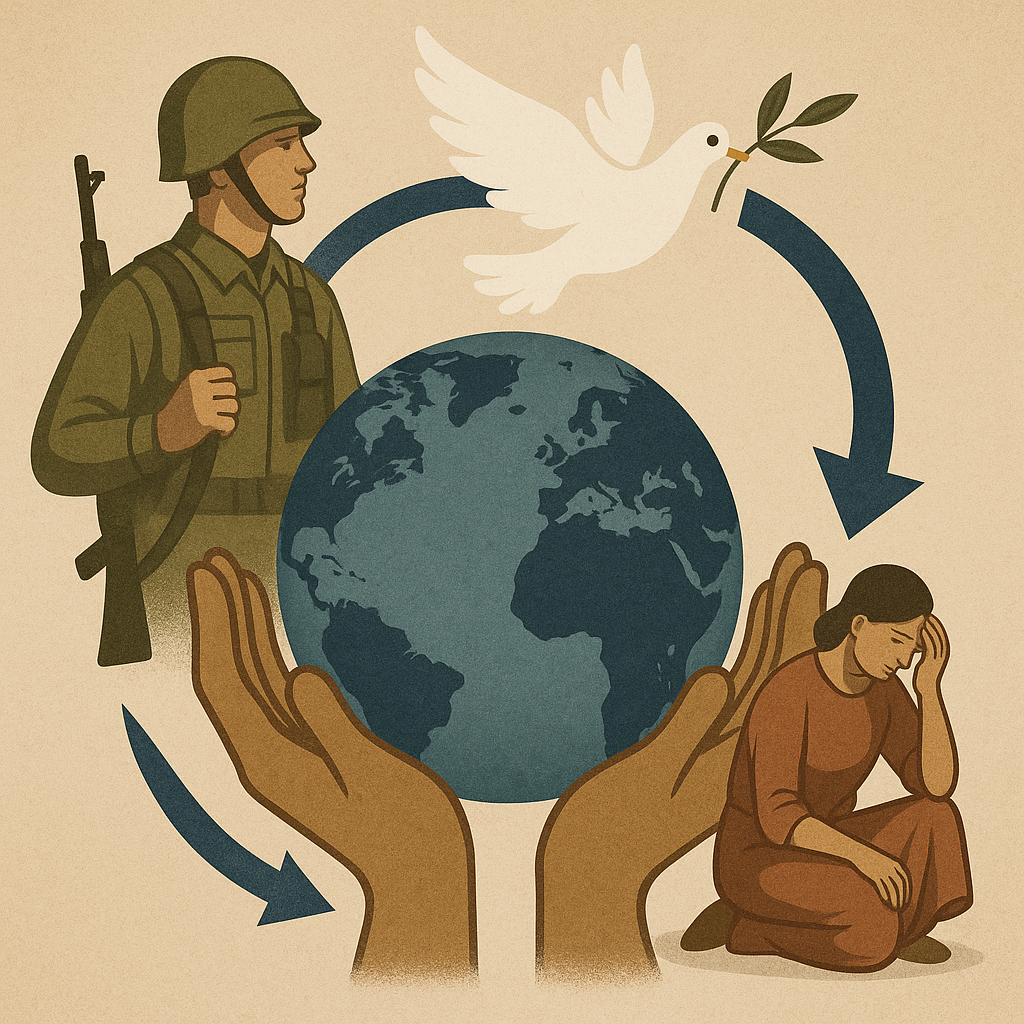International law prohibits the use of force by states at the international level. However, as a general rule, this prohibition does not extend to a state’s internal disputes. With the evolution of international law, it has become clear that, in certain circumstances, internal disputes may also give rise to international responsibility. Failure to fulfill this responsibility may lead to the state being subjected to various sanctions, including humanitarian intervention.
Humanitarian intervention is the use of force by international community, within the territory of another state, with the authorization of the UN Security Council, aimed at preventing or halting widespread and systematic violations of fundamental human rights.
Alongside humanitarian intervention, the spill-over doctrine is another approach that provides a pathway for international intervention in response to internal problems. It refers to the principle that internal conflicts, severe human rights violations, or large-scale crises within a state may produce cross-border effects that threaten regional or international peace and security, thereby justifying international concern, preventive action, or in some cases, external intervention.
This piece will analyze the legal basis and the nature of the spill-over theory; and its potential risks and challenges through the examination of relevant international legal instruments and practical applications through Libyan experience between 2011-2025.
- International Responsibility of Internal Disputes
As a general rule, international law does not concern itself with a state’s purely internal affairs, respecting the principle of state sovereignty. However, it is now widely recognized that where a state engages in grave and systematic violations of human rights within its own territory, these issues may transcend the domestic sphere and become matters of legitimate international concern. In such cases, based on articles 39-42 of the UN Charter and UN General Assembly Resolution 2625, the international community, acting through the UN Security Council, may authorize what is commonly referred to as “humanitarian intervention” to protect affected populations from crimes such as genocide, ethnic cleansing, or other large-scale atrocities, notwithstanding the principle of non-intervention.
While the Responsibility to Protect constitutes a primary obligation of states towards their own populations, the failure to fulfil this obligation may trigger the international community’s right – exercised through humanitarian intervention – to step in and protect those populations.
In response to the debates that emerged during the interventions of the 1990s in Rwanda and the former Yugoslavia, the International Commission on Intervention and State Sovereignty (ICISS) produced the non-binding “Responsibility to Protect” (R2P) report in 2001 (hereinafter “the Report”, “R2P Report” or “ICISS Report”). Although this report was not directly adopted by the UN General Assembly as a legal instrument, it has since been cited (See: paras 138-139 of UN World Summit Outcome 2005, SC Resolutions 1674, 1706, 1973) as a basis for numerous actions undertaken by UN bodies including the General Assembly and the Security Council and by the states, individually. The report, which effectively outlined the framework for humanitarian intervention, also implied another key concept: the spill-over doctrine.
- Humanitarian Intervention and Spill-Over
Humanitarian intervention focuses directly on halting grave human rights violations within a state, typically justified to protect civilians from crimes as genocide. In contrast, the spill-over doctrine addresses internal crises that cross borders and threaten regional or international peace and security. While both may lead to international action, their primary legal justifications and objectives differ. The conditions, thresholds, and implications of these two concepts are distinct.
As will be elaborated below, it is widely accepted today that severe human rights violations are likely to extend beyond a state’s borders. This perspective treats spill-over as a complementary element that reinforces the justification for intervention in cases of grave human rights abuse. Indeed, in Resolution 1973, it was emphasized that the internal violations in Libya risked spilling over. Furthermore, spill-over was effectively used as a supplementary factor to reach the threshold required for humanitarian intervention.
Therefore, spill-over functions less as an independent ground for intervention and more as a complementary factor reinforcing the justification for humanitarian intervention.
Since the spill-over concept has not yet found sufficient practical application, there is no clear certainty regarding its essence, legal basis, conditions or procedures. This paper will briefly examine all these elements to properly understand the concept.
- The Essence of the Concept: Humanitarian Safeguard or State-to-State Responsibility?
The spill-over theory essentially covers situations in which a domestic issue transcends national borders and causes harm to the surrounding region and the broader international community.
From this perspective, it is necessary to examine what distinguishes such situations from an ordinary internationally wrongful act. Under international law, the existence of fault is not a prerequisite for a state to incur responsibility; therefore, if an act within a state’s sovereign domain causes harm to another state, the injured state may make a claim for reparation. At this point, what differentiates a spill-over situation from a typical wrongful act is that the spill-over involves harm to fundamental human rightsand that the gravity of this harm gives rise to heightened international concern. (see: R2P report, page XI)
In conclusion, a spill-over situation has a dual character: on the one hand, it is a humanitarian safeguard; on the other hand, it involves a domestic matter giving rise to responsibility by causing harm to other states or risking it.
- The Legal Basis
- R2P Report (2001)
The spill-over doctrine is, by its intended purpose, aimed at the protection of human rights. The R2P Report, when introducing this concept, frames it as a form of humanitarian safeguard. However, upon closer examination, it becomes apparent that the doctrine is more concerned with protecting the rights of affected neighboring states than with the transboundary spread of human rights violations.
This shifts the concept away from its humanitarian character and brings it closer to the realm of classical responsibility. While the initial sections of the report support the concept’s nature as a humanitarian safeguard, its later parts and practical application reveal features that resemble the classical responsibility regime. This duality renders the concept ambiguous and undermines legal certainty.
As we begin to examine the relevant sections of the report:
(1) Basic Principles
- State sovereignty implies responsibility, and the primary responsibility for the protection of its people lies with the state itself.
- Where a population is suffering serious harm as a result of internal war, insurgency, repression or state failure, and the state in question is unwilling or unable to halt or avert it, the principle of non-intervention yields to the international responsibility to protect.
These principles directly aim that the state’s responsibility. However, it does not claim any evidence of a spill over situation.
Subsequently, the report addresses the international -mostly regional- consequences of domestic violations on the example of Rwanda:
‘…Its consequence was not merely a humanitarian catastrophe for Rwanda: the genocide destabilized the entire Great Lakes region and continues to do so. In the aftermath, many African peoples concluded that, for all the rhetoric about the universality of human rights, some human lives end up mattering a great deal less to the international community than others.” (Para 1.1.)
Furthermore, paragraphs 1.21 and 1.22 of the report draw attention to the increasingly interdependent nature of the international community:
“In an interdependent world, in which security depends on a framework of stable sovereign entities, the existence of fragile states, failing states, states who through weakness or ill-will harbour those dangerous to others, or states that can only maintain internal order by means of gross human rights violations, can constitute a risk to people everywhere.” (Para 1.21)
These statements demonstrate that the essence of the spill-over concept lies in its function as a humanitarian safeguard. Moreover, the “harm” perceived by the international community is addressed in a rather abstract manner; it is framed primarily in terms of human rights and the value of human life.
Consequently, in this form, spill-over is tied to criteria that are inherently difficult to measure. Furthermore, the threshold of responsibility defined through terms such as “gross violation” and “serious harm” is essentially similar to the concept of humanitarian intervention.
Nevertheless, the approach of ICISS shifts in the subsequent sections. Especially in the sections about the role of neighboring states and regional organizations, the Commission directly refers to “spill-over” and articulate more concrete and fundamentally different criteria.
“…Many human catastrophes will have significant direct effects on neighbouring countries through spill-over across national borders taking such forms as refugee flows or use of territory as a base by rebel groups. Such neighbouring states will thus usually have a strong collective interest, only part of which will be motivated by humanitarian concerns, for dealing swiftly and effectively with the catastrophe.” (R2P Report, Para. 6.31) (see also: para. 8.9)
Here, as well as in other parts of the text, the concrete manifestations of spill-over – such as refugee crises and insurgent groups – although related to human rights concerns, essentially involves a typical state responsibility.
Another point that supports the classical responsibility claim is the scenario explicitly mentioned in paragraph 1.21, which refers to the “existence of fragile states, failing states, or states that, through weakness or ill-will, harbour actors dangerous to others”. The same statement also forms the basis for established concepts such as cross-border operations, which is a concept based on the principles of classical responsibility regime.
A state has an obligation not to cause harm to another state, which includes the responsibility not to allow its own territory to be used in a manner that would inflict harm on others. When considered together with the “unable or unwilling state” doctrine that underpins the concept of cross-border operations, the authority granted to injured states in such cases is more closely linked to the classical responsibility regime than to the protection of human rights.
Viewed in this way, the spill-over scenario arguably confers upon injured states an exceptional prerogative rooted in the classical framework of interstate responsibility.
In conclusion, while the R2P Report formally frames the spill-over concept as a humanitarian safeguard, its practical application demonstrates that the real foundation may lie in the classical duty of states to prevent harm to others.
- UN Security Council’s Resolution 1973
In practice, the spill-over situation does not appear as an independent justification for intervention. However, it is generally treated as a complementary concept that helps to meet the threshold required for invoking humanitarian intervention.
Following the failure of the measures adopted under Resolution 1970 to halt the violence of Gaddafi government to the civilians such as the attacks targeting civilians and the use of disproportionate force to suppress protests, the Security Council adopted Resolution 1973 in 2011, which imposed a no-fly zone over Libyan airspace and authorized military intervention. The Council justified this decision on the grounds that the Libyan government was committing crimes against humanity, thus invoking the principle of humanitarian intervention:
“Considering that the widespread and systematic attacks currently taking place in the Libyan Arab Jamahiriya against the civilian population may amount to crimes against humanity,”
At that time, Libya was in the midst of a civil war; there were intense clashes between the Gaddafi regime and “rebel” forces. Although there were repeated instances of the Gaddafi government launching indiscriminate attacks without distinguishing between civilians and insurgents, there remained serious debates and uncertainty as to whether these violations were truly systematic or sufficiently “grave” to meet the established threshold for humanitarian intervention. (see, 2011 Report of Amnesty International)
So, since there were no possible supporting instruments other than spilling-over, the Council applied the spilling over as a complementary instrument, according to the R2P report.
However, the duality described in the previous section also appears in the text of the Resolution. Instead of focusing on human rights violations to justify the necessity of humanitarian intervention, the preambular clauses place greater emphasis on the reactions of neighboring states and regional organizations. This approach reinforces the similarity between the spill-over doctrine and state-to-state instruments such as cross-border operations, rather than humanitarian safeguard role.
“Taking note of the final communiqué of the Organisation of the Islamic Conference of 8 March 2011, and the communiqué of the Peace and Security Council of the African Union of 10 March 2011 which established an ad hoc High Level Committee on Libya,” (Resolution 1973, Preambular Clause 11)
“Taking note also of the decision of the Council of the League of Arab States of 12 March 2011 to call for the imposition of a no-fly zone on Libyan military aviation, and to establish safe areas in places exposed to shelling as a precautionary measure that allows the protection of the Libyan people and foreign nationals residing in the Libyan Arab Jamahiriya,” (Preambular Clause 12)
These paragraphs show us that the applications of regional organizations are used as evidence of regional and international threat.
“Reiterating its concern at the plight of refugees and foreign workers forced to flee the violence in the Libyan Arab Jamahiriya, welcoming the response of neighbouring States, in particular Tunisia and Egypt, to address the needs of those refugees and foreign workers, and calling on the international community to support those efforts,” (Preambular Clause 15)
Furthermore, the Council has considered that the calls of neighboring states are important to substantiate the threat to regional peace and security. Again, there is an inherent contradiction concerning the essence of spill-over: whereas the first 10 clauses address purely humanitarian situations, here the concept is invoked to support humanitarian intervention by emphasizing the harm caused by Libya’s internal actions to neighboring states. Moreover, the Council has qualified the continuing deployment of mercenaries as a spilling-over threat to regional peace as well as the refugee crisis. (See, Preambular Clause 16)
In conclusion, in the first ten preambular clauses of the resolution, the Council refers extensively to human rights violations and crimes against humanity, while in the subsequent clauses it invokes spill-over concerns to reinforce that the threshold for intervention has been met. The concept initially relied on the abstract notion of human rights violations transcending state borders and diminishing the value of human life; and then subsequently evolved into a concrete argument that neighboring states risk or suffer harm by the actions of Libya.
- The Execution
The report outlines how humanitarian intervention should be conducted in three stages: the Responsibility to Prevent, the Responsibility to React, and – most critically – the Responsibility to Rebuild.
It first establishes that the foremost pillar of the Responsibility to Protect is the Responsibility to Prevent. This principle emphasizes that the international community must act proactively to address the root causes of internal conflict, state failure, and mass human rights abuses before they escalate. Preventive measures include early warning mechanisms, diplomatic engagement, economic assistance, and capacity-building to strengthen state institutions and mitigate risks before they develop into widespread atrocities. Resolution 1970 which sought to halt the attacks against civilians in Libya through measures such as an arms and cargo embargo and travel bans is an example of these preventive measures.
When prevention fails and serious harm to civilians occurs or is imminent, the Responsibility to React comes into play. This pillar justifies collective action – ranging from sanctions and political pressure to, in extreme cases, military intervention – to halt or avert large-scale loss of life or crimes against humanity. Such interventions must adhere to the UN Charter framework, particularly through Security Council authorization. (See, Resolution 1973)
Finally, the Responsibility to Rebuild demonstrates that protecting civilians does not end with the cessation of hostilities. It requires a sustained commitment to post-conflict recovery, including restoring security and the rule of law, rebuilding governance structures, promoting reconciliation, and ensuring that the conditions that gave rise to the crisis do not recur. As the Report warns, neglecting this pillar risks turning an intervention into a source of prolonged instability and new spill-over effects.
Aftermath Of Libya: Responsibility to Rebuild and Spill Over
Of these three responsibilities, the one most directly relevant to the spill-over doctrine is the Responsibility to Rebuild. This obligation goes beyond merely repairing the harm caused by intervening forces; it also requires ensuring the stability of the affected state, establishing functioning institutions, and neutralizing armed groups that could perpetuate instability.
Although the report emphasizes that intervening forces should fulfil this responsibility without becoming an occupying power, this is hardly possible in practice.
In the case of Libya, after the war ended in October 2011, the intervening forces remained on the ground to facilitate the establishment of civil governance and post-conflict reconstruction. However, this presence failed to prevent various forms of instability within Libya and, in some cases, contributed to the emergence of new sources of unrest.
For instance, the withdrawal of Tuareg militias who had fought for Gaddafi contributed to the outbreak of new conflicts in the Sahel, such as the Malian Civil War in 2012.
Moreover, the ineffective rebuilding process led to a second civil war in Libya in 2014. One of the main arguments advanced by the government that was not recognized by the United Nations was the need to liberate Libya from what it perceived as foreign occupation. Considering the continent’s colonial history, the emergence of such perceptions was almost inevitable.
The second civil war triggered new waves of refugees and resulted in even more grave human rights violations. By the transboundary impacts, the Sahel region descended into significant chaos, while the other neighboring states such as Egypt and Tunisia confronted with heavy influxes of refugees.
Why “Rebuilding” Didn’t Work?
International law doctrine has attributed the escalation of instability to the ineffective implementation of the Responsibility to Rebuild. However, this paper argues that the root cause of the problem lies within the concept of the Responsibility to Rebuild itself, not within its application.
Rebuilding is regarded as vital for securing peace and stability in the aftermath of an intervention. Although, assigning the task of establishing post-intervention stability to the intervening parties creates a sphere that is inherently open to abuse. In principle, international law obliges parties only to remedy harm directly attributable to them. However, imposing a broader ‘rebuilding’ responsibility implicitly grants interveners additional authority in three key domains:
First, the intervening states are not held accountable for conflicts they fail to prevent and crises they indirectly cause if they do not fulfil their obligations. So, the intervening parties have the authority but not an obligation. Second, intervening parties may disregard the core principles of intervention – proportionality and necessity – by invoking their intention to ‘rebuild’ in the aftermath.
By its very nature, humanitarian intervention seeks to strike a balance of interests between respect for state sovereignty and the maintenance of international peace and security. In this regard, any infringement of sovereignty must remain proportionate. However, recognizing a responsibility to rebuild risks producing an excessive violation of sovereignty both during and after the intervention itself. For instance, the removal of a government should be an absolute last resort to end human rights abuse, yet this measure may be employed unnecessarily or beyond what is strictly required.
Furthermore, during the rebuilding phase, how proportionality and necessity are to be ensured remains vague and largely uncontrolled and indeed unaccountable, rendering the process highly susceptible to abuse.
- Doctrinal Approaches and Recommendations
There are relatively few proposals in the doctrine for addressing the problems identified in this paper. Although the recommendations offered by these studies differ, they share certain common elements.
The article by Salehyan and Gleditsch does not approach the spill-over concept as a humanitarian safeguard. Instead, it focuses on the destabilizing impact of population movements and the proliferation of armed militias, thereby framing the doctrine primarily in terms of state-to-state effects. The authors also address the Responsibility to Rebuild in a narrow and pragmatic sense, limiting it to measures such as the return and resettlement of refugees in a manner that does not infringe upon state sovereignty.
By contrast, Ezugwu, Kehinde and Duruji adopt a more skeptical view of the spill-over doctrine. Their analysis likewise approaches the concept on a state-to-state basis and argues that intervention did not reduce refugee flows or militia movements but rather exacerbated them, ultimately triggering an actual spill-over effect. In line with the argument advanced in this paper, their study also expresses skepticism toward the Responsibility to Rebuild, highlighting its potential to generate further instability rather than prevent it.
Both articles, when addressing the spill-over doctrine, focus – much like the doctrines of cross-border operations and the “unable or unwilling” state – on the obligation of a state to prevent harm to other states. Accordingly, it can be argued that the doctrine approaches spill-over more as a state-to-state instrument than as a humanitarian safeguard. The articles also converge in their concern over the ambiguity surrounding the Responsibility to Rebuild. However, while the first seeks to provide clarity by confining rebuilding obligations to tangible elements such as refugees and militias, the second argues that rebuilding is ineffective and may even prove counterproductive.
However, neither of these two articles directly addresses the threshold-lowering use of the spill-over concept, nor do they engage with the question of responsibility arising from the failure to fulfil the rebuilding obligation. This paper aligns more closely with the perspective of Ezugwu, Kehinde, and Duruji, yet aims to put forward a distinct analytical approach by analyzing these vital gaps.
- Conclusion & Recommendations
The spill-over doctrine remains marked by conceptual uncertainty and practical inconsistency. Its dual framing – as either a humanitarian safeguard designed to protect populations or as an extension of the classical duty of states not to cause harm to one another—has generated a lack of clarity that threatens legal certainty. This tension is reflected both in the R2P Report and in the Security Council’s practice, particularly in Resolution 1973, which oscillates between humanitarian rhetoric and references to regional destabilization and neighboring states’ security concerns.
Within the doctrine, two main strands of thought emerge. The first treats spill-over as an inherently humanitarian concept, tying it to the Responsibility to Protect and framing it as a safeguard for populations suffering grave human rights violations. This view places spill-over within the same normative space as humanitarian intervention, focusing on the protection of civilians and collective moral obligations. The second, more skeptical strand—adopted by authors such as Salehyan and Gleditsch and further developed by Ezugwu, Kehinde, and Duruji—interprets spill-over primarily in terms of state-to-state effects. It emphasizes refugee flows, armed militia movements, and regional destabilization, aligning the doctrine more closely with classical interstate responsibility rather than with human rights–based intervention.
This paper argues that the latter approach offers a more coherent and legally secure path. Despite its humanitarian language, the operational reality of spill-over aligns with established doctrines such as cross-border operations, the “unable or unwilling” state standard, and even elements of self-defense. Re-situating spill-over within this state-to-state responsibility framework would eliminate its current role as a “threshold-lowering” complement to humanitarian intervention and instead subject it to the necessity and proportionality standards embedded in classical jus ad bellum.
Adopting this approach would also address the persistent ambiguities surrounding the Responsibility to Rebuild. As noted in the doctrine, one view seeks to confine rebuilding obligations to tangible post-conflict measures – such as refugee return and militia demobilization – to avoid excessive infringement on sovereignty, while the more skeptical view questions whether rebuilding can ever succeed without generating further instability. This paper sides closer to the latter, but by reframing spill-over as a matter of interstate responsibility, rebuilding becomes a secondary question of state accountability for cross-border harm, rather than a vague humanitarian obligation with ill-defined limits.
Ultimately, redefining spill-over as part of the classical responsibility regime serves two purposes: it disentangles the doctrine from the contested field of humanitarian intervention and preserves the high threshold for the use of force; and it ensures that states are held accountable when their domestic actions cause or fail to prevent harm to other states. In this form, spill-over would no longer function as an ambiguous humanitarian safeguard but as a clearly delimited instrument of interstate responsibility, aligned with the structure, logic, and discipline of international law.





